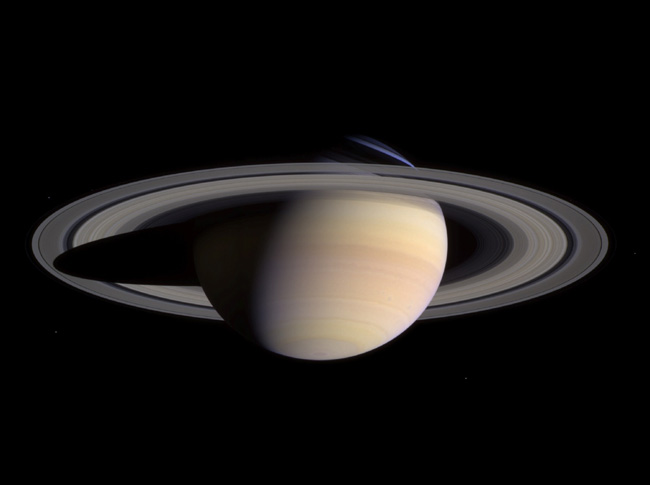The Enduring Mystery of Saturn's Rings

Editor's Note: This feature articleis part of SPACE.com's weekly Mystery Monday series.
Saturn's rings have fascinated scientists ever since Italian astronomerGalileo Galilei first spotted them through one of his telescopes in the 17thcentury. But just how the icy rings came into being remains a mystery that hasonly deepened with each new scientific finding.
Astronomers now know that the planet hosts multiple rings that consistof roughly 35 trillion-trillion tons of ice, dust and rock. The Cassinispacecraft and its Voyager predecessors have also spotted changing ringpatterns, partially formed ring arcs and even a moon spewing out icy particlesto form a new ring. All of this suggests that the rings have constantly evolvedover time.
Cassini also imaged a more recent event near the time of recent Saturnequinox, when an object apparently punched through one of the rings andleft a scarred wake of debris that again points to a dynamic, ever-changingsystem of rings.
Yet even today, just how and when each of the rings each formed remainsunknown.
Not just bands, but rocks
Scientists have learned much since Dutch mathematician ChristiaanHuygens followed up on Galileo's first sighting and figured out what the ringsrepresented in 1655. The rings consist of icy clumps, mud, rock and evenmoonlets that can cause gravitational mayhem by dipping in and out of rings.
Get the Space.com Newsletter
Breaking space news, the latest updates on rocket launches, skywatching events and more!
Jupiter, Uranus and Neptune also have fainter sets of rings. Butuncertainty still holds sway over how Saturn amassed such a spectacular ringcollection, which scientists have organized from the innermost to outermostring by the following divisions: D, C, B, A, F, G and E.
One theory suggests that the rings resulted from the debris of ashattered moon from around 4 billion years ago, during a period of heavymeteorite bombardment. A large comet or asteroid collision could also explainthe swarm of debris.
Another theory proposes that the rings represent primordial throwbacksto an early disk of debris that failed to clump into moons, based on howSaturn's gravitational tidal pull constantly stirs the pot.
Strange structures and gaps exist within the rings. Voyager firstspotted ghostly patterns cutting across the rings like spokes on a wheel, andCassini also imaged such spokes. No agreement exists on whether the spokesarose from meteoroid impacts on the rings or instability in Saturn's magneticfield. Scientists have even pointed to Saturn storms or perhapslightning as possible culprits behind the phenomenon.
Other gaps shaped like airplane propellers may have formed in the ringswhen stadium-sizedmoonlets plowed through the orbiting ring particles. The presence ofthousands of these moonlets could lend weight to the collision theory forSaturn's ring formation.
Time after time
The age of Saturn's rings also remains open. Earlier Earth-basedobservations leaned toward the ancient rings dating back billions of years,toward the beginning of the solar systems 4.6-billion-year history. Bycontrast, Voyager's swing-bys suggested a more youthful age of perhaps 200million years or so, when dinosaurs had begun to walk the Earth.
Cassini's ongoing tour of the planetary system has complicated mattersby indicating that each ring may have formed at different times and indifferent ways. The NASA spacecraft found that icy plumes from the moonEnceladus constantly feed the E ring with new material. Smaller inner moonsalso orbit within partial and complete rings formed from their own particles,probably due to impacts from micrometeroids blasting the material off theirsurfaces.
Some rings also apparently renew themselves in a way that could explainthe age discrepancy, according to Todd Barber, Cassini's lead propulsionengineer. He discussed current ring theories with Linda Spilker, Cassini'sdeputy project scientist.
"Apparently, B-ring material may be ancient but prone to bouts ofrecycling, continually clumping but then breaking up to expose fresh (andyoung-looking) water ice," Barber said. "Evidently, everything old isnew again, but perhaps old again."
Of occultation and equinox
Scientists have gotten several breaks over the past years in betterunderstanding Saturn's rings. Cassini managed to image all of Saturn's rings atonce in 2006, when the sun passed directlybehind Saturn and remained blocked by the planet for 12 hours.
Another rare event this August allowed Cassini to examine the verticaldepth of the rings during the Saturn Equinox, an event that only takes placeevery 15 years. That's when the rings turn edge-on toward the sun and reflectpractically no sunlight.
"Whenever equinox occurs on Saturn, sunlight will hit Saturn's thinrings, the ring plane, edge-on," Spilker noted.
So far, however, even the power of Cassini ? named for Giovanni Domenico Cassini, who discovered moons ofSaturn and was the first to spot a huge division in the rings that now bearshis name ?? has not revealed all of Saturn's secrets.
Cassini's extended tour through 2017 may allow the spacecraft to keeppursuing the many mysteries embedded within the rings. Scientific goals includenarrowing the age of the rings by examining the rate of meteoroid infallcontamination, gauging ring mass, seeing how propeller features form, andfiguring out how narrow ring gaps end up relatively cleared of debris.
"Like any great magician, Saturn never fails to impress,"Spilker said. A bit of occultation and equinox doesn't hurt, either.
- Video - Enceladus' Cold Faithful
- Cassini's Greatest Hits: Images of Saturn
- Special Report: Cassini's Journey's
Join our Space Forums to keep talking space on the latest missions, night sky and more! And if you have a news tip, correction or comment, let us know at: community@space.com.
Jeremy Hsu is science writer based in New York City whose work has appeared in Scientific American, Discovery Magazine, Backchannel, Wired.com and IEEE Spectrum, among others. He joined the Space.com and Live Science teams in 2010 as a Senior Writer and is currently the Editor-in-Chief of Indicate Media. Jeremy studied history and sociology of science at the University of Pennsylvania, and earned a master's degree in journalism from the NYU Science, Health and Environmental Reporting Program. You can find Jeremy's latest project on Twitter.









